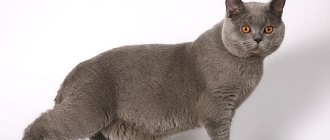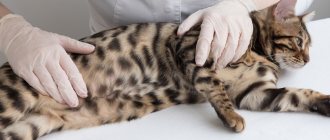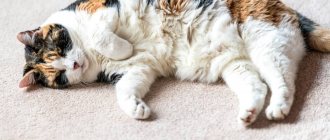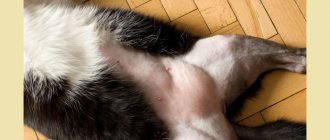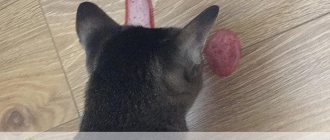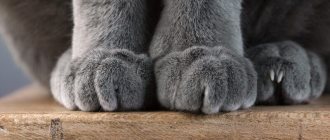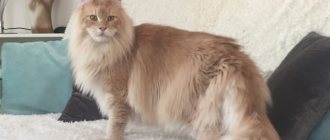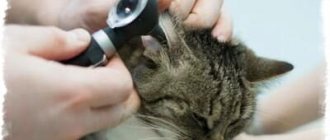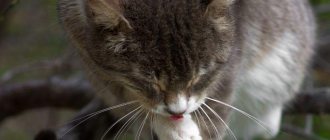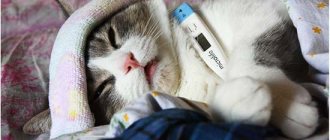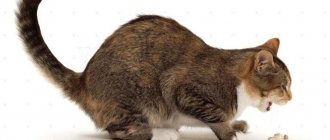Basically, a cat's tail appears when the animal has British roots. However, some other breeds also have such a belly. A saggy pouch is nothing more than fat, meaning that the animal is quite plump. After sudden weight loss, a hanging belly also appears. The fold will disappear on its own over time as soon as the skin tightens and returns to its normal position. But sometimes a fat tail or a pouch on the stomach can indicate the development of a dangerous pathology. Then, in addition to the saggy pouch, the pet will be bothered by pathological symptoms, which are impossible not to notice.
When is a hanging belly considered normal?
If a cat has skin hanging on its belly between its hind legs, and the animal is well-fed and even overweight, this is a physiological norm, because the fat tail inside is filled with accumulated fat. Owners of a British cat, as well as a Scottish fold, also notice that their pets are awarded with a belly. This is a breed feature, the exact reasons for which have not been established. In addition to the British and Scots, the sphynx, pixie-bob, bengal cat, and straight-eared Scottish straight cat have drooping bellies. For example, Scottish cats, as well as British cats, have a tummy at a young age. Pixiebobs always have soft fat in the form of a fold on their belly.
There is a theory that such bellies in the form of a fat fold protect the internal organs of cats during a fight.
Functions of the fat tail
Most domestic cats have a pedigree pouch. But in smooth-haired and hairless ones it is more noticeable than in fluffy ones. The primordial fold stretches along the lower part of the body from the stomach area to the hind limbs. Its thickness varies - in the upper part it is thinner, and in the back it thickens. Normally, the plumb line is 3-5 cm, but it can exceed these dimensions.
When the animal moves quickly, the fat tail sways from side to side. The primordial sac is a physiological feature of felines and is not a pathological condition or anomaly. Scientists cannot come to a clear opinion about the functionality of the fat tail. There are several versions that seem the most logical.
Version No. 1
It is no coincidence that a thick fold of skin is located on a cat’s belly. It protects the most vulnerable part of the body – the stomach and the organs located inside it – from injury and damage. In the wild, cats have to wade through low-growing bushes, thorns, and branches in pursuit of game. The fat tail protects against scratches, punctures and wounds.
In addition, a protective fold protects the tender belly from the teeth of large predators. Even after turning over on its back, the wild cat continues to defend itself, striking with its strong hind legs and long, strong claws. A dense but movable fold of skin prevents damage to internal organs. In this case, the fat tail works like folds in the skin around the neck of fighting dogs - it prevents damage to muscles and large blood vessels.
Assumption No. 2
Fat tail is an accumulation of adipose tissue. Mast cells store fat, which is a source of energy for biochemical processes in the body. For wild animals such a “warehouse” is simply necessary. After all, they do not have owners who regularly provide high-calorie food.
The predator is full if the hunt is successful and uses fat reserves when the time of hunger comes. If the cat has a good appetite, then you will notice that the size of the fat tail increases, it becomes denser and thicker. If you reduce the portion, the fold size will decrease.
Hypothesis No. 3
The primordial sac is an additional volume of skin that facilitates movement. In a rapid run, the animal stretches out almost into a string or jumps sharply upward, changes the direction of movement - for all these manipulations it is necessary that the skin does not limit the rotation of the joints and does not stretch.
Additionally, in females, excess skin may develop after pregnancy. Over time, the plumb line will decrease and the skin will tighten. A stretched skin fold can also form after an animal loses weight. In both cases, this phenomenon is reversible. Stretched skin is also different when palpated. It is flabby, looser in structure, less thick. It takes some time for the skin to return to normal.
There is no need to worry if your older cat starts to develop skin folds. As an animal ages, collagen production decreases and the skin becomes less firm and elastic. Degenerative tissue changes in elderly pets are natural and are not a pathology.
Physiological fat tail should not cause concern to the owners of a furry pet. It does not cause discomfort to the animal.
The cat happily exposes its tummy to scratching and stroking, leads an active lifestyle, eats and sleeps calmly.
Reasons for changes
In other cat breeds, pouches on the tummy often indicate good nutrition. It is often possible to notice how such a belly sags in a castrated cat leading an inactive lifestyle. If such a fold bothers the animal, the owner should take care of changing the diet, thanks to which the pet will be able to lose excess weight. Almost always, a cat's belly hangs in the first few days after giving birth. But as soon as the cat recovers, the loose skin will return to its normal position and the tummy will become the same as before.
A drooping belly in a cat can be a symptom of a disease, one of which is ascites.
However, sometimes a cat’s belly hangs down as a symptom of dangerous internal disorders, among which the following are common:
- Cushing's syndrome;
- ascites;
- bladder rupture;
- benign or malignant tumor;
- bloating;
- helminthic infestation;
- intestinal obstruction or coprostasis.
Breed characteristics
In some cat breeds, the fat tail is a characteristic breed feature. As a rule, these are breeds that were created with the participation of wild cats or indigenous breeds. The primordial sac is very pronounced in representatives of:
- Canadian sphinxes;
- Cornish Rex;
- Scottish Straights (Scottish Straight);
- pixie-bob (short-tailed elf);
- Bengal cats;
- savannas;
- Canaan cats;
- chausie.
Even the graceful savannah has a slight plumb line, and in Bengal cats and pixie-bobs, this exterior feature is even indicated in the breed standard.
Hybrid breeds have inherited this conformation feature from their wild parents. Even small kittens have a small “apron” of skin next to their hind legs.
In Scottish cats, the fat tail is not expressed in all breed lines. In the European line, where the British were used to create the breed, the primordial sac is expressed even in kittens. And with age it sags even more. In the American line, according to felinologists, there is no such feature, since aboriginal smooth-haired animals were used in the creation of this Scottish breed line.
Dangerous symptoms
If a British, Scottish Sphynx or Pixie Bob has a loose underbelly, while the fat tail is stable in size, does not cause discomfort and looks like an integral part of the animal’s body, there is no need to worry about its appearance, since this is a physiological breed feature. However, when, in addition to the fact that the cat has a pouch hanging in the lower abdomen, there are pathological symptoms, the owner needs to take the pet to an appointment with the veterinarian as soon as possible. The following symptoms should alert you:
- rapid increase in abdominal size;
- edema formation;
- acute pain when pressed;
- change in skin color;
- decreased appetite;
- sudden weight loss;
- deterioration in general health.
Gradual increase in abdominal volume in a cat
Belyakov Denis Aleksandrovichanesthesiologist-resuscitator
Owners often pay attention to the gradual increase in abdominal volume, but do not always attach great importance to this, thinking that their animal has simply gained weight. However, a gradual increase in abdominal volume, sometimes quite long (from several weeks to several months), can serve as a sign of various pathological conditions
Let's talk about the most common ones.
- Enlargement of the abdomen due to the accumulation of free fluid in the abdominal cavity - ascites. As a rule, ascites is a sign of cardiovascular diseases or diseases of the liver, less often the kidneys, and the gastrointestinal tract. The belly of such animals looks saggy. If you lift a cat by its front paws, the fluid moves down and the belly becomes pear-shaped.
- The accumulation of thick, fibrin-flaked, straw-colored fluid in the abdominal cavity may be a sign of feline infectious peritonitis (FIP). This is a very serious, incurable viral disease. Kittens and young animals often get sick. A sick cat's abdomen progressively enlarges against the background of general exhaustion.
- In oncological diseases of the abdominal organs, an increase in abdominal volume is associated with tumor growth. When examining such an animal, you can sometimes feel a dense formation; if you look at the animal from above, you can often notice the asymmetry of the abdomen.
- In females, a disease called pyometra often occurs. With this pathology, the uterine cavity is filled with purulent contents, and the amount can be so significant that it leads to an increase in the shape of the abdomen. Treatment in this case is only surgical, and the sooner this disease is diagnosed and the sooner treatment is started, the greater the chance for the animal to recover faster after surgery.
- In obesity, fat deposits on the abdominal wall can mimic an increase in abdominal volume. This is especially true for domestic cats, in which fat in the initial stage of obesity is distributed unevenly throughout the body, mainly in the lower abdomen and in the groin area. And we see a moderately well-fed animal with a large, saggy belly.
All these conditions can occur against the background of the relative well-being of the animal, but this is a condition for the time being. The cat owner should clearly know that a gradual increase in the abdomen can be a normal option only in case of pregnancy (obesity is not considered as a normal option).
So if you notice that your pet's belly has increased recently, it is best to visit a veterinary clinic as soon as possible.
At the appointment, the veterinarian will ask in detail about the symptoms that brought you and your animal to the clinic, carefully examine your cat and, if there is indeed evidence of a disease, will carry out the necessary diagnostic measures (ultrasound of the abdominal cavity, x-rays of the abdominal cavity and chest in two projections ). To assess the general condition of the cat, clinical and biochemical blood tests will be taken.
For ascites, your doctor may perform a puncture in the abdominal wall (laparocentesis) to take a sample of ascites fluid for laboratory testing. If the cat’s condition leaves much to be desired, she is lethargic, and has shortness of breath, the doctor will use a puncture in the abdominal wall to remove some of the fluid from the abdominal cavity. This is necessary to alleviate the patient’s condition and normalize the functioning of the heart, lungs and other vital organs until the cause of ascites is determined.
It may be that to make a final diagnosis, you will need to consult a highly specialized specialist: a cardiologist, oncologist, or surgeon.
In controversial cases, when it is not possible to make an accurate diagnosis (this is usually the case with oncological diseases of the abdominal organs), a diagnostic laparotomy may be required. This is an abdominal operation. An incision is made in the abdominal wall and a visual inspection (examination) of the abdominal organs is performed. This method allows you to establish the area (localization) of the pathological process, determine operability (that is, the ability to eliminate the problem surgically), and immediately carry out surgical treatment of the detected disease or carry out invasive diagnostic procedures (tumor biopsy, identification of portacaval shunts, etc.).
That's how difficult this problem of abdominal enlargement can be. Don't wait for a miracle, seek help as quickly as possible. Your cat will be grateful to you, because all of the above diseases are better and more effectively treated in the early stages.
Diagnostics
Diagnosis of manifestations involves a number of procedures, such as ultrasound of internal organs.
Even two or three pathological signs should be a reason to immediately take your four-legged friend to see a doctor. During the initial examination, the veterinarian will try to find out the main reasons why the cat’s belly hangs. To determine the diagnosis and prescribe adequate treatment, a referral is given to undergo a number of such diagnostic procedures:
- general clinical analysis of blood and urine;
- biochemistry;
- puncture and histological examination of the contents of the sac;
- Ultrasound of internal organs.
What is fat tail
A cat has a fat tail - a medium-sized pouch of skin and fat on the abdomen. It happens in dogs too. Scientifically called the primordial or rudimentary sac.
In long-haired individuals, the fur hides the belly, so the tail is inconspicuous. The short-haired cat and the Sphynx have a pronounced skin formation.
The cat's belly hangs from behind, in the area of its hind legs. The thickness of the fat tail is determined by the fat layer and varies.
Sagging should not exceed 5 cm, otherwise internal pathologies should be suspected.
Domestic cats inherited their fat tails from their wild relatives. In the latter, the sagging of the abdomen is pronounced; the bag sways noticeably when walking and jumping. And in domestic cats, a hanging tummy can be almost invisible. The volume of the fat tail varies by season: in spring and summer the fat layer decreases, in the cold period fat increases.
Reasons for appearance
The exact causes of the appearance of a skin-fat pouch in cats have not been established. Scientific research confirms that functionally the fat tail is an important formation provided for by evolution:
- The stomach of cats is a vulnerable part of the body that is not protected by the skeleton, and abdominal injuries and pathologies are deadly. Scientists believe that the skin bag with a fat layer is a protective formation. Thanks to the fat tail, a cat sneaking during the hunt does not risk scratching or piercing its belly with a sharp branch or stone.
- There is another idea why cats need a primordial sac: it is a storehouse of nutrients. The theory is confirmed by the fact that the fat tail is most noticeable in obese cats, decreases in the summer heat, and increases in the cold season, when the body accumulates fats to prevent winter hunger. In nature, with a prolonged absence of prey, the body begins to consume nutrients from the abdominal pouch.
- The third probable cause of sagging belly is the way cats move. The skeleton of predators is flexible and mobile. During the hunt, the joints of the limbs are stretched, the spinal column bends vertically and horizontally at a significant angle. For freedom of body movements, elasticity and folding of the skin is necessary. The fat tail allows you to bend your spine as much as possible.
- The protective function of the fat tail may be to prevent injury to the abdominal organs during territorial fights with relatives. Cats that are grappling tend to strike hard with their hind paws in the area of the opponent's stomach, tearing the skin with their claws. The fat tail protects the abdominal organs from serious injury.
What treatment is prescribed?
If a cat has loose skin on its abdomen as a result of severe internal diseases, a comprehensive drug therapy regimen is prescribed, aimed at eliminating the original source of the problem. It happens that the pet’s condition is serious, then the veterinarian decides to hospitalize the cat. Sometimes conservative methods are ineffective in combating the causes that caused a cat’s belly to sag and a fat tail to appear. Then surgical treatment is carried out followed by rehabilitation.
If Scottish Fold or British cats are obese, for example, after sterilization, and because of this their tummy becomes like a bag, the doctor will advise the owner to put his four-legged friend on a therapeutic diet, which will help him get rid of excess weight. When the fat tail sags for natural reasons, no measures should be taken. The main thing is that the cat is in good health, in a good mood and that nothing bothers him.
Pregnancy and childbirth of a cat
Pregnancy is one of the most important periods in a cat’s life, and you should become her main assistant. On average, a cat's gestation period is 63-66 days. But it is possible for kittens to be born at 58 - 71 days. The first day is the day of mating plus 36 hours. As a rule, primiparous cats carry a little longer. A pregnant cat should be treated like a crystal vase:
The first weeks of pregnancy are quite difficult to determine (there are no laboratory tests to determine pregnancy in cats yet), but there are certain signs that will tell you whether your cat is pregnant or not.
The character may change (the cat becomes more affectionate, demands attention, occasionally there are cats that become aggressive)
But at the same time, the presence of pregnancy can be determined using an ultrasound, starting from about 14 days after mating. X-rays can detect pregnancy only after 40 days, since previously the skeletons of embryos are invisible in X-rays (ultrasound and X-rays can detect any pathology in advance and prevent undesirable consequences, but they will not show the exact number of kittens).
A veterinarian will be able to determine pregnancy approximately 20 days after mating by palpation, but not later, since the uterus will be filled with fluid and it will be possible to feel the fetuses only at 49-55 days. But this procedure must be performed by a very experienced doctor, otherwise it may lead to undesirable consequences.
You also need to pay special attention to feeding your cat. To feed cats, it is necessary to use special super-premium food (for growing and lactating cats, or food for kittens) throughout pregnancy
Remember that a pregnant cat has an increased need for quality nutrition. And therefore, starting from the 3rd week of pregnancy, the feeding rate
Source
